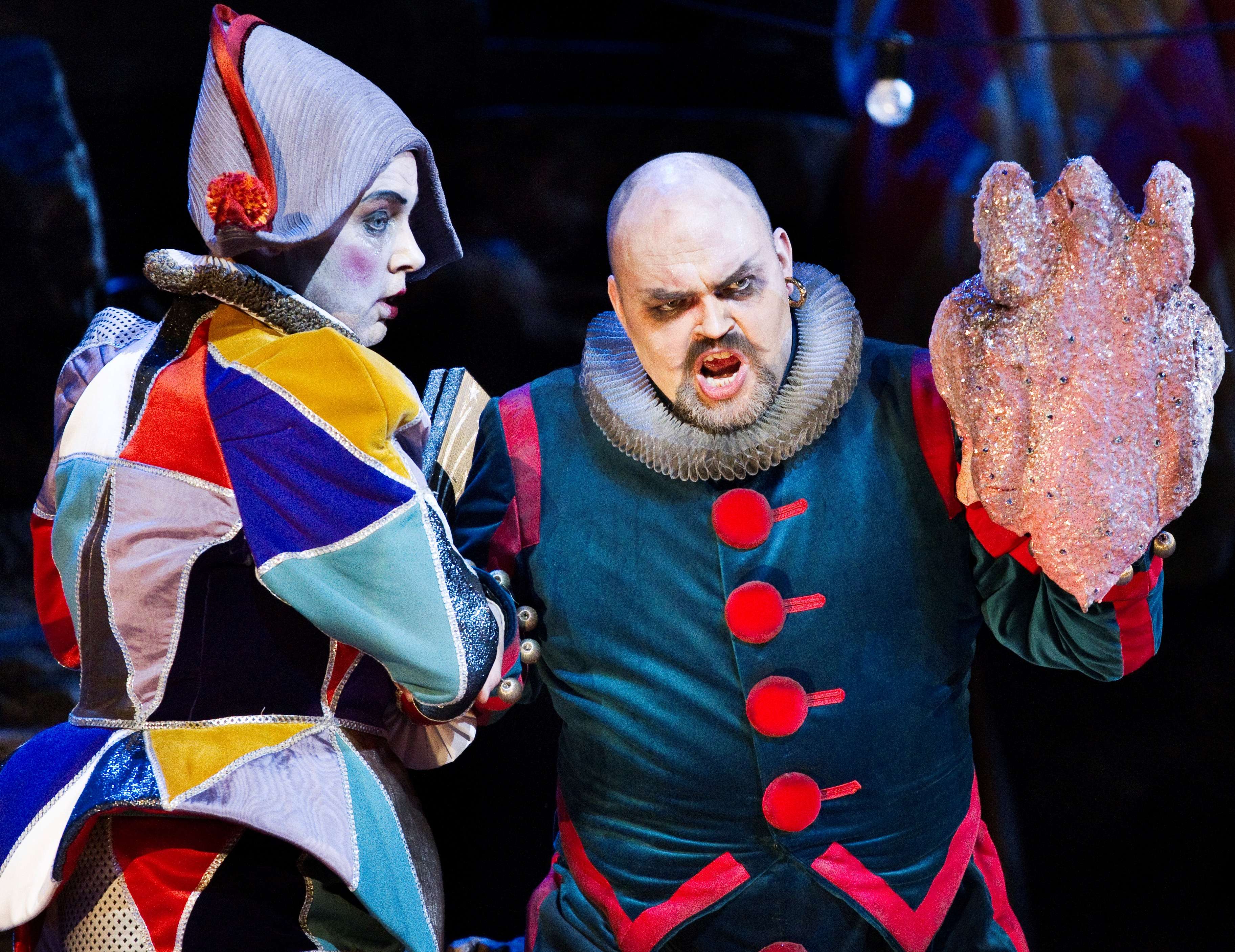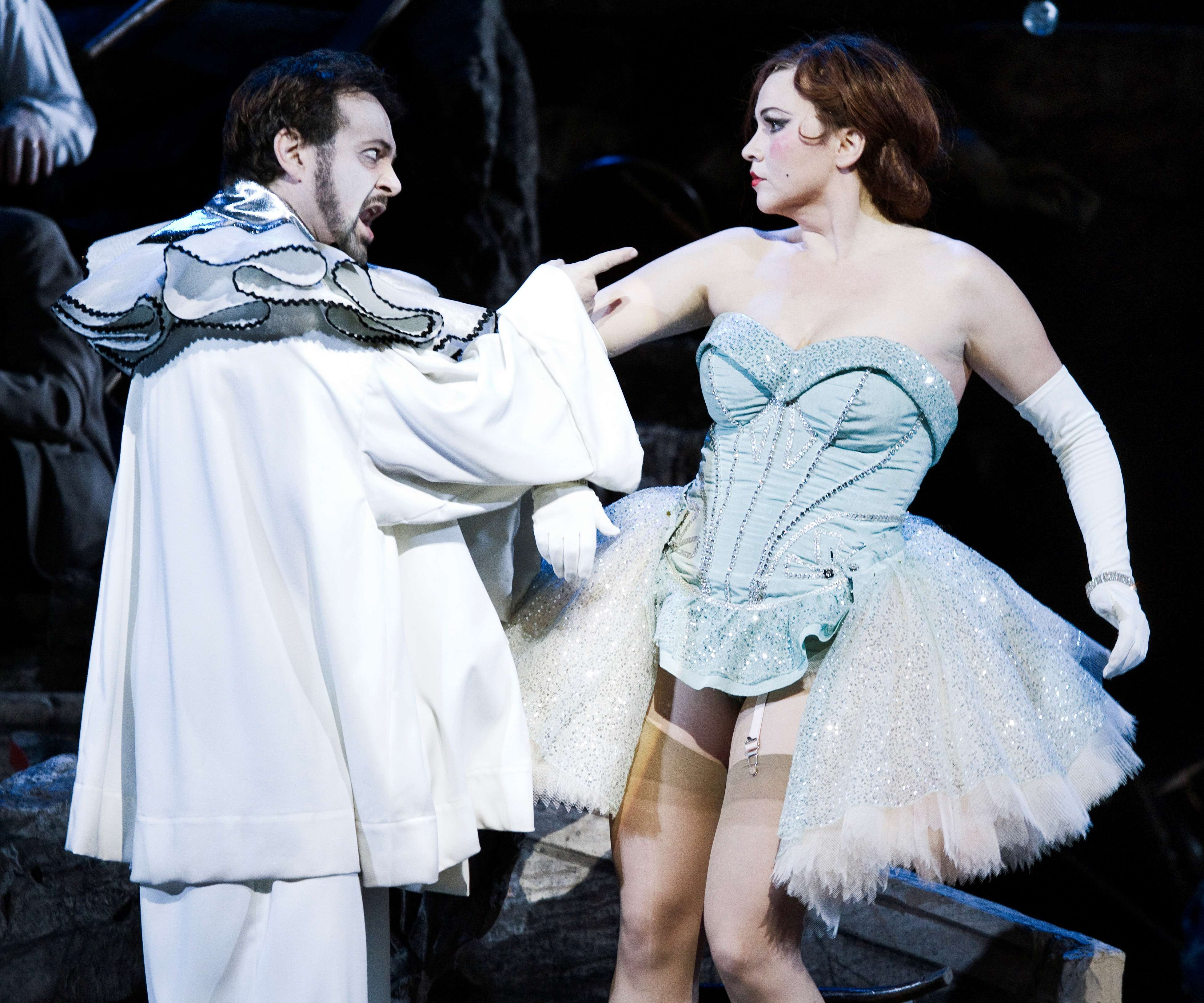|
Back
A Window on Jealousy and Revenge Copenhagen
The Royal Danish Opera House, Main Stage
12/12/2011 - & December 15, 17, 19, 27, 29* 2011, January 2, 4, 8, 10, 12, 22, 24, 30, February 2, 4, 2012
Pietro Mascagni: Cavalleria Rusticana
Ruggiero Leoncavallo: Pagliacci (*)
Cavalleria Rusticana: Susanne Resmark (Santuzza), Roy Cornelius Smith (Turiddu), Randi Stene (Lucia), Fredrik Zetterström (Alfio), Hanne Fischer (Lola)
Pagliacci: Roy Cornelius Smith (Canio), Sine Bundgaard (Nedda), Fredrik Zetterström (Tonio), Michael Kristensen (Peppe), Palle Knudsen (Silvio), Carl Rahmqvist and Hans Lawaetz (Villagers)
Paul Curran (*), Kasper Holten (stage directors), Mia Stensgaard (set designer), Anja Vang Kragh (costume designer), Bruno Poet (lighting designer)
The Royal Danish Opera Orchestra and Chorus, Philip White (chorus master), Stefano Ranzani (conductor)

M. Kristensen & F. Zetterström
(© Miklos Szabo/Courtesy of Royal Danish Opera)
In the Royal Danish Opera’s new production of the two verismo operas that are traditionally performed together, Cavalleria Rusticana and Pagliacci, the rational and balanced Danish audience gets a glimpse of a world of seething passion, jealousy, and bloody revenge on a personal level. In Mascagni’s opera, a desperate and socially rejected woman knowingly sets up a duel where her former lover is stabbed to death, while in Leoncavallo’s, the avenger is a troupe leader who is about to lose his wife, the star of his show, once a penniless waif he provided for, seduced, and married, to a younger man.
As a teenager, I was regularly shocked by mentions in the press of men who had killed their wives in Italy in a rage of jealousy, stood trial, and been set free. It was therefore with fascination that I watched these double revenge tragedies, which were set in a Sicilian village around 1900 and after World War II.
Under the baton of Stefano Ranzani, the Royal Danish Opera orchestra, put forth the proper emotional ante from the start, with a fine variation in Cavalleria Rusticana between themes of simple country living, doubt, expectation, despair, and emotional climax. The Italian verismo sound continued in Pagliacci; the full orchestra played with power and precision on the very day that a cut-down process began for the company.
Mia Stensgaard (set designer) uses the vertical to create the public space of an Italian village – not a piazza, but massive sandstone steps leading up to an ancient church - which continues up the hill. The set keeps the chorus singing directly to us and renders a fantastic Easter procession with churchmen in full headgear and lace, and villagers dressed up for the holy celebration. Anja Vang Kragh’s (costume designer’s) talent was even more visible in Pagliacci, with the comic players in bright garb among their audience – men, women and children in 1940s styles - and weary soldiers – in a bombed-out town with half-destroyed stairs draped with cast-off stars-and-stripes.

S. Resmark (© Miklos Szabo/Courtesy of Royal Danish Opera)
The principals lived up to the high standards. Cavalleria Rusticana started with a solitary and sad Susanne Resmark (Santuzza), dressed in red, wandering around the church. A passionate Italianate tenor voice from behind stage serenaded Lola, wife of Alfio, a hardworking carter. Santuzza caught a glimpse of the lovers before the chorus in black peasant clothes drifted onto the steps, lauding the virtues of country life. They settled for a rest on the stairs, completely ignoring and even threatening Santuzza as she walked past.
Kasper Holten (stage director, Cavalleria Rusticana) has made Santuzza’s dilemma as desperate as it can be: she is excommunicated and rejected by society, while her lover suffers no consequences. We observed the bitterness of her existence, her prayers to the Virgin Mary, her tender pleading with Turridu to come back to her. Holten – in collaboration with the principals - has considered the score throughout, since every movement and emotion on stage grew out of the music, as must be the case with verismo art at its best.
For the first time, Resmark has taken on a dramatic soprano role. She sang the part quite naturally, with a strong high register without shrillness or wobble, a voice capable of rising above the full choir and orchestra in the Easter refrain. Her more slender physique was also appropriate, if not necessary, for the role.
Roy Cornelius Smith (Turiddu) is a skilled actor who understands his character and manages to portray him as more than an insensitive egoist driven by hormones and pride. With a dramatic tenor voice that has dark overtones, Smith had the stamina to last the evening in the demanding roles of Turiddu and Canio (Pagliacci). His voice attained a metallic persistence at the heights of anger, his eyes bulged and flashed, his body language became aggressive, and he led us into very tragic endings.

R. C. Smith & S. Bundgaard
(© Miklos Szabo/Courtesy of Royal Danish Opera)
Sine Bundgaard (Nedda) was at her best with a double-edged charisma, singing with fresh lyrical sweetness as her character dreamed of freedom like the birds and then changing to a sexy commedia actress in the play within the play. She captivated the audience and her male counterparts and was innocent and worldly at the same time.
Fredrik Zetterström (Alfio and Tonio) was notable in both roles, delivering an articulate forceful baritone and a portly, muscular presence that is quite appropriate for these tough guy roles. He was frightening as he challenged Turridu, eloquent in the prelude to Pagliacci, and later a brute intent on securing Nedda’s demise. Tenor Michael Kristensen (Beppe) made us laugh as the good clown, but suddenly delivered an aria so poignantly that he seemed alone on the stage. Credit must be given to Bruno Poet (lighting designer), who skillfully emphasized key moments in both productions. Palle Knudsen (Silvio) was a fine sweetheart for Bundgaard’s Nedda. His lyric baritone was soft and loving, and his fit youthful physique suited the role perfectly.
Throughout Pagliacci, the dispositions of Paul Curran (stage director) created a dramatic whole that amplified and reflected Leoncavallo’s score and libretto. We felt how easily revenge and irrationality can arise when life is a great struggle, or when the very structure of life suddenly changes in a negative direction.
What interesting and different voices we were privilege to that evening, what tragedies were witnessed, and what a wonderful respite from the order and efficiency of our daily lives!
Kathleen Gail Jensen
|